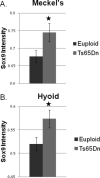Non-trisomic homeobox gene expression during craniofacial development in the Ts65Dn mouse model of Down syndrome
- PMID: 23843306
- PMCID: PMC3729611
- DOI: 10.1002/ajmg.a.36006
Non-trisomic homeobox gene expression during craniofacial development in the Ts65Dn mouse model of Down syndrome
Abstract
Trisomy 21 in humans causes cognitive impairment, craniofacial dysmorphology, and heart defects collectively referred to as Down syndrome. Yet, the pathophysiology of these phenotypes is not well understood. Craniofacial alterations may lead to complications in breathing, eating, and communication. Ts65Dn mice exhibit craniofacial alterations that model Down syndrome including a small mandible. We show that Ts65Dn embryos at 13.5 days gestation (E13.5) have a smaller mandibular precursor but a normal sized tongue as compared to euploid embryos, suggesting a relative instead of actual macroglossia originates during development. Neurological tissues were also altered in E13.5 trisomic embryos. Our array analysis found 155 differentially expressed non-trisomic genes in the trisomic E13.5 mandible, including 20 genes containing a homeobox DNA binding domain. Additionally, Sox9, important in skeletal formation and cell proliferation, was upregulated in Ts65Dn mandible precursors. Our results suggest trisomy causes altered expression of non-trisomic genes in development leading to structural changes associated with DS. Identification of genetic pathways disrupted by trisomy is an important step in proposing rational therapies at relevant time points to ameliorate craniofacial abnormalities in DS and other congenital disorders.
Keywords: developmental delay disorders; experimental animal models; genotype-phenotype correlation; trisomy 21.
Copyright © 2013 Wiley Periodicals, Inc.
Figures

References
-
- Ait Yahya-Graison E, Aubert J, Dauphinot L, Rivals I, Prieur M, Golfier G, Rossier J, Personnaz L, Creau N, Blehaut H, Robin S, Delabar JM, Potier MC. Classification of human chromosome 21 gene-expression variations in Down syndrome: impact on disease phenotypes. Am J Hum Genet. 2007;81:475–491. - PMC - PubMed
-
- Allanson JE, O'Hara P, Farkas LG, Nair RC. Anthropometric craniofacial pattern profiles in Down syndrome. Am J Med Genet. 1993;47:748–752. - PubMed
-
- Arron JR, Winslow MM, Polleri A, Chang CP, Wu H, Gao X, Neilson JR, Chen L, Heit JJ, Kim SK, Yamasaki N, Miyakawa T, Francke U, Graef IA, Crabtree GR. NFAT dysregulation by increased dosage of DSCR1 and DYRK1A on chromosome 21. Nature. 2006;441:595–600. - PubMed
-
- Barrow JR, Capecchi MR. Targeted disruption of the Hoxb-2 locus in mice interferes with expression of Hoxb-1 and Hoxb-4. Development. 1996;122:3817–3828. - PubMed
Publication types
MeSH terms
Substances
Grants and funding
LinkOut - more resources
Full Text Sources
Other Literature Sources
Medical
Molecular Biology Databases
Research Materials

